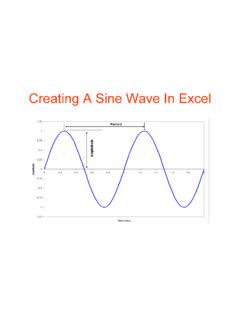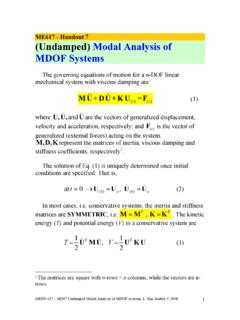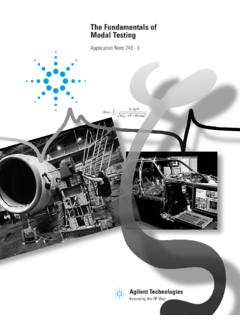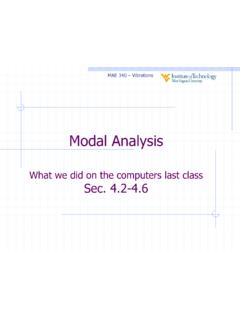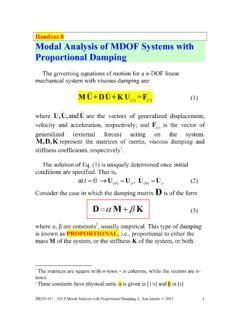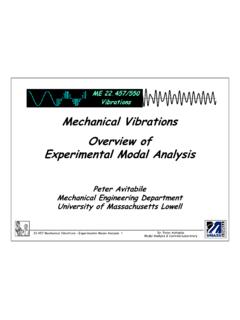Transcription of STEP-BY-STEP PROCEDURE FOR SETTING UP A SPREADSHEET FOR ...
1 SE 180 Earthquake Engineering November 3, 2002 STEP-BY-STEP PROCEDURE FOR SETTING UP A SPREADSHEET FOR USING NEWMARK S METHOD AND modal analysis TO SOLVE FOR THE RESPONSE OF A MULTI-DEGREE OF FREEDOM (MDOF) SYSTEM Start with the equation of motion for a linear multi-degree of freedom system with base ground excitation: gu&&&&&m1kuucum =++ Using modal analysis , we can rewrite the original coupled matrix equation of motion as a set of un-coupled equations. giii2iiiuMLqq2 q&&&&& =++ , i = 1, 2, .., NDOF with initial conditions of oiid0)(td== and oiiv0)(tv== Note that total acceleration or absolute acceleration will be q&giabsiuq&&&&&+= We can solve each one separately (as a SDOF system), and compute histories of and their time derivatives. To compute the system response, plug the q vector back into and get the u vector (and the same for the time derivatives to get velocity and acceleration). iq qu= The beauty here is that there is no matrix operations involved, since the matrix equation of motion has become a set of un-coupled equation, each including only one generalized coordinate.
2 Nq In the SPREADSHEET , we will solve each mode in a separate worksheet. Step 1 - Define System Properties and Initial Conditions for First Mode (A) Begin by SETTING up the cells for the Mass, Stiffness, and Damping of the SDOF System (Fig. 1). These values are known. (B) Set up the cells for the modal participation factor iiMLand mode shape i (Fig. 1). These values must be determined in advance using modal analysis . (C) Calculate the Natural Frequency of the SDOF system using the equation Ahmed Elgamal Michael Fraser 1 iiMK=i (Equation 1) Note: If the system damping is given in terms of the modal Damping Ratio ( i ) then the Damping ( c ) can be calculated using the equation: Ci = 2 i i Mi (Equation 2) (D) Set up the cells for the 2 Newmark Coefficients & (Fig. 1), which will allow for performing a) the Average Acceleration Method, use 21 = and 41 =. b) the Linear Acceleration Method, use 21 = and 61=.
3 (E) Set up cells (Fig. 1) for the initial displacement and velocity (do and vo respectively) Ahmed Elgamal Michael Fraser 2 Equation 1 Equation 2 Figure 1: SPREADSHEET After Completing Step 1 Ahmed Elgamal Michael Fraser 3 Step 2 Set Up Columns for Solving The Equation of Motion Using Newmark s Method Base ExcitationApplied Force Divided By MassRelative AccelerationRelative VelocityRelative Displacement Figure 2: SPREADSHEET After Completing Step 2 Place a cell (Fig. 2) for the time increment ( t). Place columns (Fig. 2) for the time, base excitation, applied force divided by mass, relative acceleration, relative velocity, and relative displacement. Ahmed Elgamal Michael Fraser 4 Step 3 Enter the Time t & Applied Force f(t) into the SPREADSHEET ttti1i+=+ (Equation 3) (Fig. 3) For the earthquake problem (acceleration applied to base of the structure), the applied force divided by the mass is calculated using: digiiiiuMLM(t)f&& = (Equation 4) (Fig.)
4 3) where, & is the applied base acceleration igu&at step i. (Typically this is the base excitation time history) Check theThey must bof the ma units of the input motion file. e compatible with the units ss, stiffness, and damping! Equation 4 Equation 3 Figure 3: SPREADSHEET After Completing Step 3 Ahmed Elgamal Michael Fraser 5 Step 4 Compute Initial Values of the Relative Acceleration, Relative Velocity, Relative Displacement, and Absolute Acceleration (A) The Initial Relative Displacement and Relative Velocity are known from the initial conditions (Fig. 4). od0)q(t== (Equation 5) ov0)(tq==& (Equation 6) (B) The Initial Relative Acceleration (Fig. 4) is calculated using o2ogd v2 uMiLi)0t(q == &&&& (Equation 7) Equation 7 Equation 6 Equation 5 Figure 4: SPREADSHEET After Completing Step 4 Ahmed Elgamal Michael Fraser 6 Step 5 Compute Incremental Values of the Relative Acceleration, Relative Velocity, Relative Displacement, and Absolute Acceleration At Each Time Step (Fig.
5 5) (A) ()*mqq tq2 1 t21 Kqq2 tCuMLq1iii21ii11ig111i ++ + =++&&&&&&&&&& (Equation 8) ()i1ii1iq t q 1 tqq&&&&&&++ =++ (Equation 9) ()ii21i2i1iq tq tq2 12 tqq+++ =++&&&&& (Equation 10) Where, the effective mass, K CM*m11112tt++= Equation 8 Equation 9 Equation 10 Figure 5: SPREADSHEET with values for the Relative Acceleration, Relative Velocity, and Relative Displacement at Time Step 1 (B) Then, highlight columns I, J, & K and rows 4 through to the last time step (in this example 4003) and Fill Down (Ctrl+D). See Figures 6 and 7. Ahmed Elgamal Michael Fraser 7 Figure 6: Highlighted Cells Ahmed Elgamal Michael Fraser 8 Figure 7: SPREADSHEET After Filling Down Columns I through K Ahmed Elgamal Michael Fraser 9 Step 6 Create Additional Worksheet for Second Mode Make a copy of the 1st Mode worksheet by right clicking on the 1st Mode tab and selecting Move or Copy (Fig.
6 8) Figure 8: Creating a Copy of 1st Mode Worksheet Then check the box for Create a copy and click on OK button (Fig. 9) Ahmed Elgamal Michael Fraser 10 Figure 9: Creating a Copy of 1st Mode Worksheet Rename this worksheet by right clicking on the 1st Mode (2) tab and selecting Rename . Rename this worksheet 2nd Mode (Fig. 10) Enter the appropriate values for M2, K2, C2, 22ML, 2, do, and vo (Fig. 10). Ahmed Elgamal Michael Fraser 11 Figure 10: Worksheet for Second Mode Step 7 Repeat Step 6 for Additional Modes Step 8 Determine the Response at Each of the Floors Determine the Response of the first floor using the equations: qu= q u&&= q u&&&&= For example for a 2 DOF structure, the first floor response is 2121111qqu += (Equation 11) 2121111qqu&&& += (Equation 12) 2121111qqu&&&&&& += (Equation 13) and the second floor response is 2221212qqu += (Equation 14) Ahmed Elgamal Michael Fraser 122221212qqu&&& += (Equation 15) 2221212qqu&&&&&& += (Equation 16) The first floor absolute acceleration is (Equation 17) g1T1uuu&&&&&&+= The second floor absolute acceleration is & (Equation 18) g2T2uuu&&&&&+= Ahmed Elgamal Michael Fraser 13

